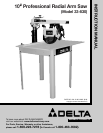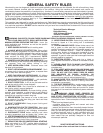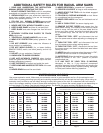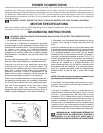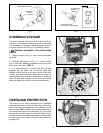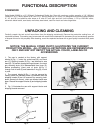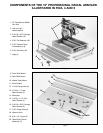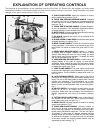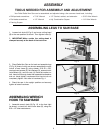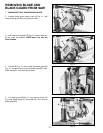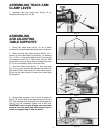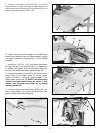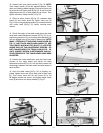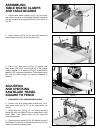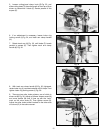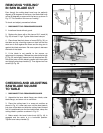
3
ADDITIONAL SAFETY RULES FOR RADIAL ARM SAWS
1. READ AND UNDERSTAND THE INSTRUCTION
MANUAL BEFORE OPERATING THIS TOOL.
2. DO NOT OPERATE THIS TOOL until it is completely
assembled and installed according to the instructions.
3. OBTAIN ADVICE from your supervisor, instructor, or
some other qualified person if you are not thoroughly
familiar with operating this tool.
4. FOLLOW ALL WIRING CODES/recommended
electrical connections. PROPERLY GROUND the tool.
5. NEVER USE TOOL WITHOUT GUARDS in place.
6. KEEP BLADE SHARP and free of rust and pitch.
7. KEEP BLADE and arbor flanges free from dirt and
grease.
8. SECURELY FASTEN END PLATES TO TRACK
ARM prior to use.
9. TIGHTEN ALL CLAMP HANDLES prior to use.
10.WEAR EYE PROTECTION (safety glasses or face
shield.
11.DO NOT OPERATE while under the influence of
drugs, alcohol, or medication.
12.DO NOT WEAR GLOVES, tie, or loose clothing.
REMOVE RINGS, watch, and other jewelry, and roll up
sleeves.
13.DO NOT cut any workpiece “freehand”.
14.KNOW HOW TO AVOID KICKBACK.
15.USE ANTI-KICKBACK FINGERS when ripping.
Lower the guard on the infeed end and adjust the anti-
kickback attachment properly.
16.USE THE FENCE to support and guide the work.
17.KEEP ARMS AND HANDS OUT OF PATH of the saw
blade.
18.NEVER REACH around the saw blade.
19.NEVER PERFORM a “crossed arm” operation.
20.PROPERLY SUPPORT all long or wide workpieces.
21.NEVER START THE TOOL with the blade engaged
in the workpiece.
22.FOLLOW ALL RIPPING WARNINGS on tool. Never
rip a workpiece from the wrong end.
23.NEVER FEED WORK into the anti-kickback end of
the tool.
24.USE A “PUSH-STICK” for narrow ripping work.
25.REMOVE CUT-OFF PIECES and scraps from the
table before cutting. The vibration of the tool may cause
them to move into the path of the saw blade and be
thrown out. After cutting, and after the blade has come
to a complete stop, turn the tool off and remove all
debris.
26.TURN THE TOOL “OFF” and disconnect the tool
from the power source before adjusting or changing set-
ups.
27.TURN THE TOOL “OFF” and disconnect the tool
from the power source when making repairs.
28.TURN THE TOOL “OFF”, disconnect the tool from
the power source, and clean the table/work area before
leaving the tool.
29.NEVER leave the work area when the power is “ON”,
or before the tool has come to a complete stop.
30.IMPORTANT: When the tool is not in use, the switch
should be locked in the “OFF” position to prevent
unauthorized use.
31.IF ANY PART OF YOUR TOOL IS MISSING,
damaged, or fails, or if any electrical component
performs improperly, shut off the switch and remove the
plug from the power supply. Replace missing, damaged,
or failed parts before resuming operation.
Use proper extension cords. Make sure your extension cord is in good condition and is a 3-wire extension cord
which has a 3-prong grounding type plug and matching receptacle which will accept the tool’s plug. When using an
extension cord, be sure to use one heavy enough to carry the current of the tool. An undersized cord will cause a
drop in line voltage, resulting in loss of power and overheating. Fig. A, shows the correct gauge to use depending on
the cord length. If in doubt, use the next heavier gauge. The smaller the gauge number, the heavier the cord.
EXTENSION CORDS
Fig. A
Fig. A
MINIMUM GAUGE EXTENSION CORD
RECOMMENDED SIZES FOR USE WITH STATIONARY ELECTRIC TOOLS
Ampere Total Length Gauge of
Rating Volts of Cord in Feet Extension Cord
0-6 120
up to
25 18 AWG
0-6 120 25-50 16 AWG
0-6 120 50-100 16 AWG
0-6 120 100-150 14 AWG
6-10 120
up to
25 18 AWG
6-10 120 25-50 16 AWG
6-10 120 50-100 14 AWG
6-10 120 100-150 12 AWG
10-12 120
up to
25 16 AWG
10-12 120 25-50 16 AWG
10-12 120 50-100 14 AWG
10-12 120 100-150 12 AWG
12-16 120
up to
25 14 AWG
12-16 120 25-50 12 AWG
12-16 120
GREATER THAN 50 FEET NOT RECOMMENDED
MINIMUM GAUGE EXTENSION CORD
RECOMMENDED SIZES FOR USE WITH STATIONARY ELECTRIC TOOLS
Ampere Total Length Gauge of
Rating Volts of Cord in Feet Extension Cord
0-6 240
up to
50 18 AWG
0-6 240 50-100 16 AWG
0-6 240 100-200 16 AWG
0-6 240 200-300 14 AWG
6-10 240
up to
50 18 AWG
6-10 240 50-100 16 AWG
6-10 240 100-200 14 AWG
6-10 240 200-300 12 AWG
10-12 240
up to
50 16 AWG
10-12 240 50-100 16 AWG
10-12 240 100-200 14 AWG
10-12 240 200-300 12 AWG
12-16 240
up to
50 14 AWG
12-16 240 50-100 12 AWG
12-16 240
GREATER THAN 100 FEET NOT RECOMMENDED



